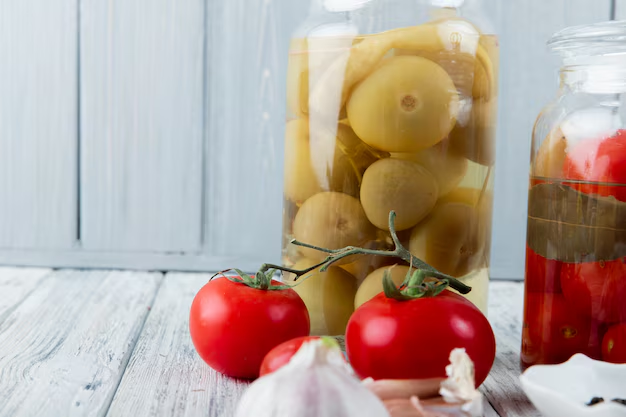Should You Store Tomatoes in the Refrigerator? What You Need to Know
When it comes to storing fruits and vegetables, home cooks often find themselves in a pickle—especially concerning where and how to store tomatoes. You've picked up those luscious, red gems from the market, only to pause and wonder: should you keep them on the countertop or stash them in the refrigerator? This question has sparked debates and myths that range from flavor preservation to longevity.
Let's explore whether your tomatoes belong in the fridge and dive into related insights on how to get the most out of this versatile fruit.
🍅 The Great Tomato Storage Debate
Understanding Tomato Composition
To grasp why there's so much fuss about tomato storage, it's essential to understand their composition. Tomatoes are high in water content, which contributes to their plump, juicy nature. However, this same trait makes them susceptible to texture changes under different storage conditions. Additionally, the enzyme systems within tomatoes are sensitive to temperature, affecting their flavor profile.
Room Temperature vs. Refrigerator: The Core Differences
Flavor and Aroma: Tomatoes reach their peak flavor through enzymatic reactions that occur at room temperature. Refrigeration slows down these reactions, potentially dampening the taste that so many cherish.
Texture: Cold temperatures can alter the cell structure in tomatoes, often resulting in a mealy or mushy texture when they return to room temperature.
Shelf Life: While refrigerating can prolong the life of fully ripe tomatoes by slowing down decay, it might come at the cost of taste and texture.
🤔 When Does Refrigeration Make Sense?
Although the general advice leans towards room temperature, there are situations where refrigeration can be beneficial.
Overripe or Sliced Tomatoes
If you have overripe tomatoes or if they've been sliced, refrigeration may be the best choice to increase their lifespan and avoid waste. In such cases, it's better to sacrifice some flavor for extending their usability.
Extremely Hot Climates
In regions with very high temperatures and humidity, refrigeration might be the best option to prevent tomatoes from spoiling quickly. If you're dealing with particularly warm conditions, keeping tomatoes cool can be more practical than keeping them at room temperature.
📦 Storing Tomatoes on the Counter
Guidelines for Countertop Storage
- Choose Wisely: Only store tomatoes that are not overripe on the counter.
- Keep Them Stem Side Up: This can minimize bruising and helps maintain integrity at the top.
- Sunlight: Avoid direct sunlight to prevent overripening.
- Ventilation: Ensure they are in a well-ventilated area to decrease the risk of mold.
Use a Layering Method
Placing tomatoes in a single layer without crowding them reduces pressure and potential bruising. Cloth or paper towels can provide cushioning and absorb any moisture, potentially extending their freshness.
👨🍳 Unlocking Full Flavor: Using Refrigerated Tomatoes
Even if you need to refrigerate your tomatoes, you can still retain some level of their delicious taste.
Bringing Back the Flavor
Acclimation Time: Before you plan to use refrigerated tomatoes, remove them from the fridge and let them sit at room temperature for a few hours. This helps bring back texture semblance and allows flavor compounds to reactivate to some extent.
Cooking: Using refrigerated tomatoes in cooked dishes like sauces, stews, or soups is an excellent way to enjoy them. Cooking can mask any texture change, and flavors can meld into exciting new profiles.
🥗 Versatility of Tomatoes
Tomatoes are incredibly versatile and used in varying cuisines worldwide. Knowing how to store them correctly directly contributes to how they perform in your favorite recipes.
Patio Salsa and Fresh Salads
- Fresh Salsa: Always use room-temperature tomatoes for making salsa to enjoy a vibrant taste.
- Caprese Salad: Pair room-temperature tomatoes with buffalo mozzarella, basil, and a drizzle of balsamic vinegar for the ultimate summer dish.
Cooking Staples
- Tomato Sauces: Refrigerated tomatoes can still shine in slow-cooked sauces and soups, where long cooking times enhance their deep, robust flavors.
- Roasting: Roasting can create concentrated flavors, turning even slightly texture-compromised tomatoes into a caramelized delight.
🚀 Quick Reference Summary
To make your tomato storage choices more straightforward and enhance readability, here's a handy guide:
| 💡 Tomato Type | 🏡 Where to Store | ⏳ Shelf Life | 📝 Tips |
|---|---|---|---|
| Fresh & Firm | Room Temperature | 1-2 weeks | Keep stem-side up and dry |
| Overripe | Refrigerator | 3-5 days | Remove before use for flavor |
| Cut Tomatoes | Refrigerator | 1-2 days | Cover with plastic wrap |
| Hot Climate | Refrigerator | Varies | Store if room temp is high |
🌟 Conclusion
Whether you should refrigerate your tomatoes boils down to their ripeness, the climate in which you live, and how soon you plan to use them. Understanding these factors empowers you to make informed decisions, maximizing flavor, texture, and shelf life. Let this guide serve as a valuable resource in unlocking the full potential of your tomatoes, bringing delightful creations to your table every time. Enjoy the colorful journey of culinary exploration with the confidence that comes from well-stored tomatoes! 🍅
